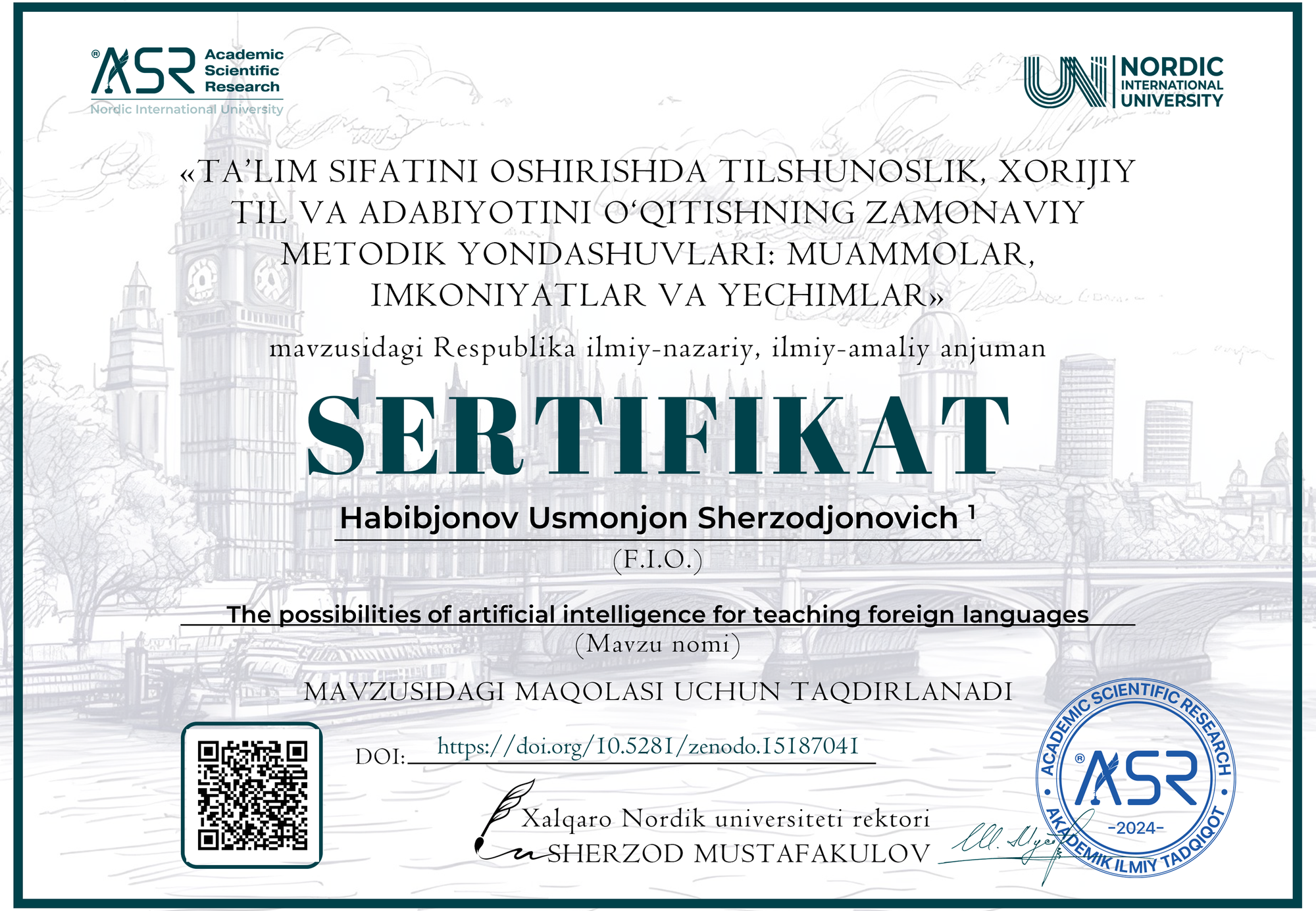Habibjonov Usmonjon Sherzodjonovich1

DOI: https://doi.org/10.5281/zenodo.15187041
Google scholar: https://scholar.google.com/scholar?hl=ru&as_sdt=0%2C5&q=%22THE+POSSIBILITIES+OF+ARTIFICIAL+INTELLIGENCE+FOR+TEACHING+FOREIGN+LANGUAGES%22&btnG=
Zenodo community: https://zenodo.org/records/15187041
Nordic_press journal: https://research.nordicuniversity.org/index.php/nordic/article/view/2291
MAQOLANI YUKLAB OLISH
SERTIFIKATNI YUKLAB OLISH
REVIEW:
The article by Usmonjon Sherzodjonovich Habibjonov explores the transformative potential of artificial intelligence (AI) in the realm of foreign language education. The author examines various AI-powered tools and technologies that are revolutionizing the language learning process, such as intelligent tutoring systems, natural language processing (NLP) applications, and adaptive learning platforms. The research effectively outlines how AI can enhance personalized learning experiences and improve learner outcomes.
Strengths:
Clear Overview of AI Applications: The article provides a comprehensive exploration of how AI technologies are applied in foreign language education. Through real-time feedback, interactive exercises, and immersive learning environments, AI has the potential to make the language learning process more engaging, effective, and tailored to individual learners’ needs.
Engagement and Motivation: The paper discusses how AI-driven platforms, such as Duolingo and Rosetta Stone, have been successful in improving both learner engagement and motivation. The findings, showing a 40% increase in users learning foreign languages through AI-based platforms, are convincing and highlight AI’s potential to keep learners engaged.
Teacher-Student Collaboration: The author advocates for a collaborative model where AI supports teachers rather than replaces them. This approach emphasizes the role of educators in leveraging technology to enhance their teaching methods, which is an important aspect often overlooked in discussions about AI in education.
Personalization and Interactivity: The article excellently emphasizes AI's ability to create personalized and interactive learning experiences. The integration of AI technologies like machine learning allows platforms to adjust to the unique needs of each student, fostering a more individualized and effective learning environment.
Statistical Evidence: The inclusion of statistical data further strengthens the argument for AI in language learning. Research findings, such as the 65% of learners reporting improved results through AI-based programs, offer strong evidence of AI’s effectiveness in this field.
Weaknesses:
Technological Limitations and Privacy Concerns: While the article acknowledges the challenges posed by AI, such as technological limitations and data privacy issues, these concerns could be explored in greater depth. For instance, the article could discuss how AI platforms can address privacy challenges, given the increasing reliance on personal data in learning systems.
Teacher Roles and Adaptation: The article briefly mentions that AI could potentially reduce the role of traditional teachers, but this issue could be elaborated further. It would be valuable to discuss how educators can adapt to these technological changes and how the role of the teacher will evolve in the AI-enhanced classroom.
Over-reliance on Technology: Although AI offers many advantages, the risk of over-reliance on technology could be addressed more thoroughly. In some cases, AI-driven learning might limit critical thinking and creativity, areas where human instruction excels.
Opportunities for Future Development:
Interactive and Immersive Environments: The suggestion to use AI in conjunction with Virtual Reality (VR) and Augmented Reality (AR) technologies to create immersive language learning environments is particularly promising. It offers a potential for students to engage in real-world contexts, thereby enhancing language acquisition in ways that traditional methods cannot.
Automated Translation and Comprehension: AI’s role in enhancing translation and comprehension tools, such as Google Translate and DeepL, is an exciting development. These tools help learners understand grammar and pronunciation in context, accelerating the learning process.
Support for Teachers: The use of AI as a support tool for teachers—helping them to track student progress and provide targeted feedback—is a practical and innovative approach. AI can help educators identify where students are struggling and suggest appropriate resources, thus enhancing teaching effectiveness.
Conclusion:
The article presents a well-rounded analysis of the possibilities and challenges associated with using artificial intelligence in foreign language education. While AI has the potential to significantly improve personalized learning, interactivity, and engagement, the article correctly points out that its integration into education should be approached with caution. Teachers and students alike can benefit from the tools AI provides, but the human element in teaching should not be disregarded.
The paper provides valuable insights into how AI can shape the future of language education, but also highlights the need for balanced, ethical, and thoughtful implementation. Overall, this research is a highly relevant and timely contribution to the growing discourse on the intersection of artificial intelligence and education.
Suggestions for Future Research:
Future studies could delve deeper into the ethical concerns surrounding AI in education, such as biases in AI algorithms, the digital divide, and the long-term effects of AI on student-teacher relationships. Additionally, exploring the effectiveness of different AI platforms across various age groups and educational contexts would further enrich the discussion.



